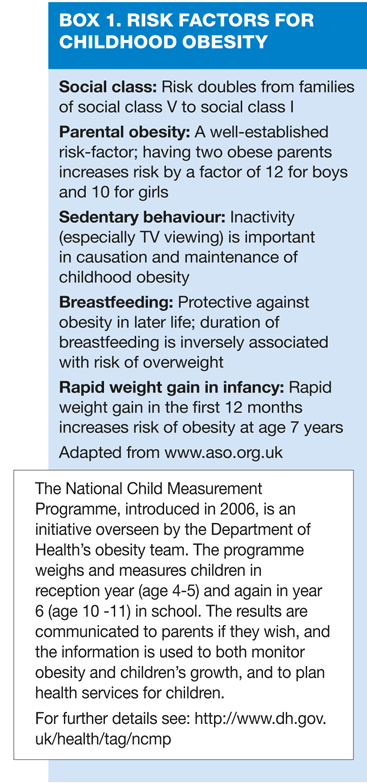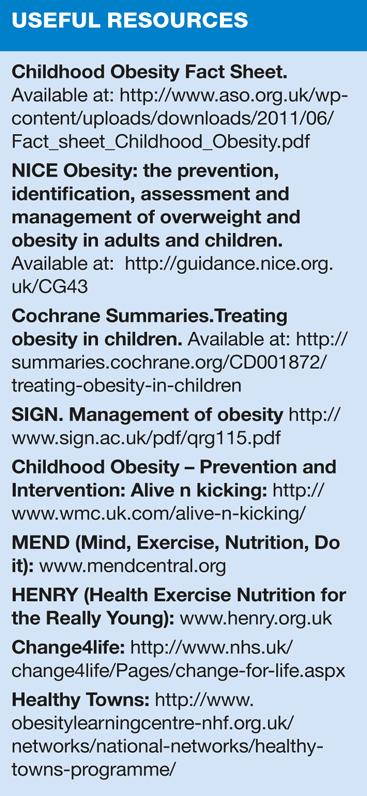Facing up to childhood obesity
Dr Frankie Phillips RD RPHNutr
Dr Frankie Phillips RD RPHNutr
Independent registered dietitian, Torquay
Child obesity is a serious problem with potentially profound health and social consequences, not least the increased risk becoming an obese adult. In the wake of National Childhood Obesity Week, we ask why children are becoming more obese, why this is a problem, and what is recommended in terms of practice
Figures from the latest Schools National Child Measurement Programme show that around one-third of children in the UK are overweight or obese. It has been estimated that by 2050, the number could rise to an alarming two-thirds of children.1
In the UK, the prevalence of obesity has more than tripled since the 1980s. The latest Health Survey for England (HSE) data shows that in 2010, 62.8% of adults (aged 16 or over) were overweight or obese, 30.3% of children (aged 2-15) were overweight or obese and 26.1% of all adults and 16% of all children were obese.2 Statistics suggest that the trend appears to be plateauing, but the 2007 Foresight Tackling Obesities: Future Choices report forecast that two-thirds of children would be obese by 2050 if no action is taken. The report also estimated that the direct and indirect costs of obesity could be £49.9bn.1
Becoming overweight or obese is the result of consuming more energy (calories) than needed, alongside too little physical activity, although this is a highly-simplified overview. The reason for the increase in childhood obesity is a tangled web of complex factors: individual decisions made by parents and children themselves in the context of human biology, culture, the food environment (plentiful availability of highly palatable and low-cost food) and the physical environment (increasingly sedentary lifestyles, screen time and car usage). In the UK, several risk factors for childhood obesity have been identified (see box 1).3 For almost all obese children, the origin of obesity lies in lifestyle factors; genetic causes of obesity are extremely rare.
MEASURING OBESITY
The body mass index (BMI) is the most commonly used method of measuring obesity, and is the best available way to measure obesity prevalence at a population level. It is calculated by dividing a person's weight (in kilograms) by the square of their height (in metres).
In children, although BMI is a useful measure, it varies with age and sex, and so interpreting BMI is more complex. There is no single cut off point to denote overweight and obesity as there is for adults. Consequently, an online calculator linked to gender-specific growth reference charts can be used to interpret BMI measurements in children.4 The calculator is available at www.healthforallchildren.co.uk. The growth charts are both cautious and conservative, such that any children identified above the cut-offs for obesity would almost certainly be excessively fat and at increased health risk. Other measures to identify obesity use waist circumference alongside BMI; waist circumference is a useful measure as fat in this area is the most hazardous to health. A recent study5 showed that 6% of boys and 15% of girls from a sample of 15,000 11-year-olds were identified as obese using the waist circumference measurement, but were in the normal BMI category, suggesting that some obese children may be overlooked when using BMI alone. Consequently, figures from the National Child Measurement Programme may be an underestimation.
The problem of childhood obesity is also exacerbated by parents' apparent inability to recognise when their child is overweight. Simply 'eyeballing' a child is insufficient to determine whether they are obese. A survey by parenting website Netmums6 showed that a third of all parents did not actually measure their child or take them to be measured by a health professional, with parents of overweight children frequently believing them to be a healthy weight. In addition, the Netmums survey found that parents are worried about speaking to their children about weight in case it leads to an eating disorder or lowers self-esteem.6 By correctly and professionally identifying overweight and obesity, steps can be taken to address this difficult matter.
HEALTH CONSEQUENCES
Many children who are obese or overweight are happy and confident. However, there are potentially serious health and social consequences, both on short term health, as well as longer-term wellbeing.
Short-term consequences
Childhood obesity goes beyond a cosmetic issue. The most significant short-term consequences are social and psychological. These may include discrimination and prejudice, with ensuing effects on the developing sense of self and self-esteem, potentially leading to a poor body image, which may increase susceptibility to eating disorders in later life, and depression.
Raised markers of cardiovascular disease (CVD) risk have also been associated with childhood obesity, for example, raised blood lipids and insulin and high blood pressure. It is estimated that two-thirds of obese primary school aged children will have at least one of these CVD risk factors, and both type 2 diabetes and CVD have been observed in UK adolescents.
Increased risk of asthma, and exacerbation of existing asthma, joint problems and fatty liver have also been observed in obese children.
Longer term consequences
It is not inevitable that an obese child will become an obese adult, although sadly there is substantial evidence that childhood obesity tracks into adulthood: more than 70% of obese children and 85% of obese adolescents will become obese adults.
Earlier signs of puberty in girls have been observed, with obesity cited as the main factor; the average age is now ten years earlier than in the last century at just over age ten, with some girls showing signs of puberty even earlier.
Obesity in childhood, independent of adult weight, has been associated with an increased risk of ill health, poor socio-economic outcomes and ultimately risk of premature death. However, a recent UK systematic review7 suggests that treating obesity during childhood could remove risk of lasting harm, and even suggests that there may be a slight protective effect of being overweight as children, provided BMI is reduced to normal by adulthood. The review found that those at the lower end of BMI in childhood who become obese as adults had the greatest risk of high blood pressure, type 2 diabetes and CVD. The greatest risk appears to be for those who are obese as children and continue to remain obese as adults, and it is unclear whether weight loss interventions in adulthood can fully ameliorate the risks associated with childhood obesity.7
Nevertheless, it is not disputed that targeting childhood and adolescence for prevention and treatment of obesity is needed to establish a healthy adult weight.
PREVENTING CHILDHOOD OBESITY
Reviewing the short and longer-term consequences of childhood obesity, it is clear that prevention, by a range of potential interventions, is a vital step to be taken.
Some progress is being made, whereby prioritising the issue can stimulate a positive change. Almost half of NHS commissioners have prioritised childhood obesity, and those areas that have done so saw a 7% reduction in the number of obese children compared with areas where this was not a priority.
Initiatives from the Government, including Change4life and Healthy Towns are helping to raise awareness of ways to live more healthily. In addition, the National Child Measurement Programme provides a strong evidence base on child obesity prevalence, and is a useful channel through which children found to be overweight or obese can be signposted to appropriate services for treatment.
In terms of the evidence for prevention of childhood obesity, the most recent systematic reviews from NICE, the Cochrane Collaboration, and the Scottish Intercollegiate Guidelines Network (SIGN) have all found that there are no clearly successful prevention strategies that can be generalised outside research settings. However, there are some clear features and recommendations for preventative programmes, which should aim to be:
- Multi-component, addressing diet and physical activity
- Emphasise positive behaviour changes that can be maintained
- Involve family and peer support
- Age-appropriate
- Consider gender, socio-economic status and ethnicity
- Developed in consultation with the target population3
Interventions should aim to support overweight children to 'grow into' their weight as opposed to losing weight per se; for healthy children, the approach should support them in maintaining healthy weight alongside normal growth. Clearly, any intervention should consider changes in the context of quality of life and behaviour changes and incorporate evaluations on cost effectiveness and sustainability.
Essentially a holistic approach is needed, with substantial change requiring action from Government, private and non-governmental organisations and the individuals themselves.
TREATING CHILDHOOD OBESITY
Considering the already significant number of children who are obese in the UK, prevention alone is insufficient; management and treatment of those who are already obese is also important.
Major reviews of treatments for obesity in childhood (NICE, Cochrane and SIGN, see Useful resources) have failed to show a clear feasible treatment pathway but, as with prevention programmes, a number of common components have been identified. These include :
- Dietary and physical activity changes
- Behaviour change components
- Family-based (involving at least one parent/carer)
Intervention should only be undertaken where the child and family recognise obesity as a problem and are willing to make lifestyle changes. The treatment should aim for weight maintenance (to 'grow into' weight) to some degree, reductions in sedentary behaviour (such as screen time), increases in appropriate physical activity, and dietary changes (in particular a reduction in energy-dense food and drinks). Several programmes currently exist, including Alive n kicking, MEND (Mind, Exercise, Nutrition, Do it), and HENRY (Health Exercise Nutrition for the Really Young).
CONCLUSION
Childhood obesity continues to be a major public health challenge and clearly requires a multi-faceted approach to prevention as well as management.
The implications and consequences of childhood obesity for both the individual and for society are of increasing concern. Strategies to prevent and treat obesity in children have been suggested, along with identification of some of the underlying causes, with comprehensive approaches including both dietary, physical and behaviour change components in the whole family lifestyle setting.
A number of approaches and programmes are available, but effectively changing obesity-related lifestyle and behaviour choices will require joined up action from Government, private and non-Governmental organisations as well as individuals and their families.
REFERENCES
1. Government Office for Science Foresight. Tackling Obesities: Future Choices. Available at: http://www.foresight.gov.uk/
2. Health Survey for England
3. Association for the study of obesity. Childhood obesity Fact sheet. http://www.aso.org.uk/wp-content/uploads/downloads/2011/06/Fact_sheet_Childhood_Obesity.pdf
4. Health for all children: www.healthforallchildren.co.uk
5. The InterAct Consortium. Long-Term Risk of Incident Type 2 Diabetes and Measures of Overall and Regional Obesity: The EPIC-InterAct Case-Cohort Study. PLoS Med 2012; 9(6): e1001230. doi:10.1371/journal.pmed.1001230
6. Netmums. Netmums calls for action on childhood obesity http://www.netmums.com/home/netmums-campaigns/netmums-calls-for-action-on-childhood-obesity
7. Lloyd LJ, Langley-Evans SC and McMullen S. Childhood obesity and risk of the adult metabolic syndrome: a systematic review. International Journal of Obesity 2012; 36:1-11; doi:10.1038/ijo.2011.186
Related articles
View all Articles

